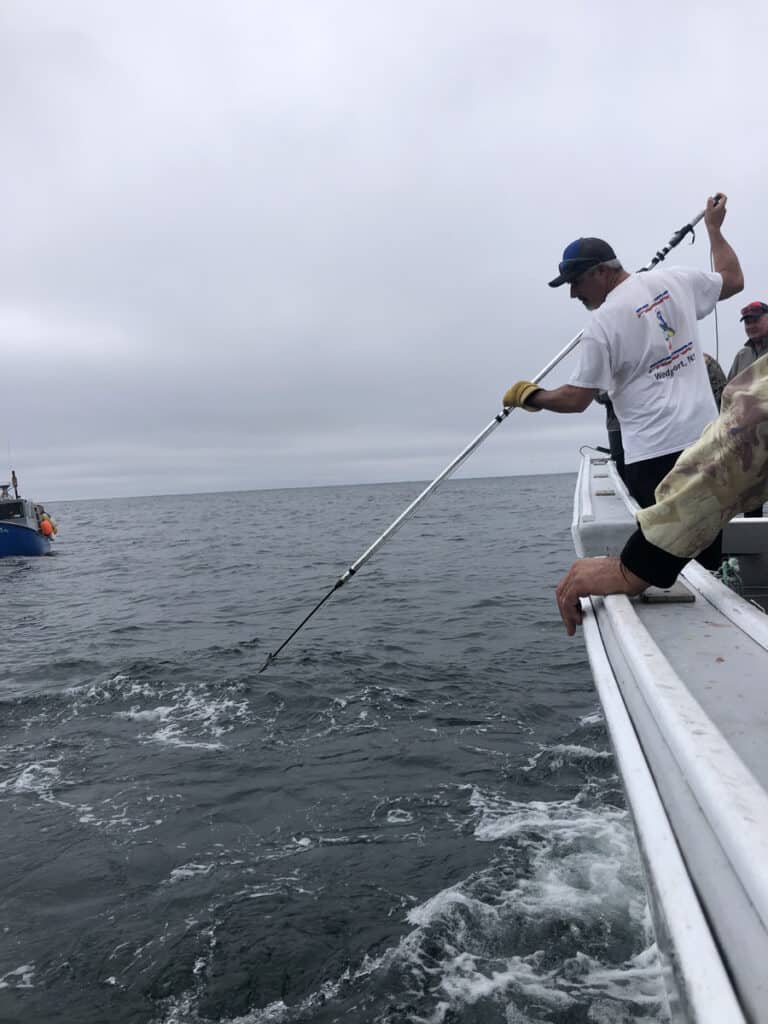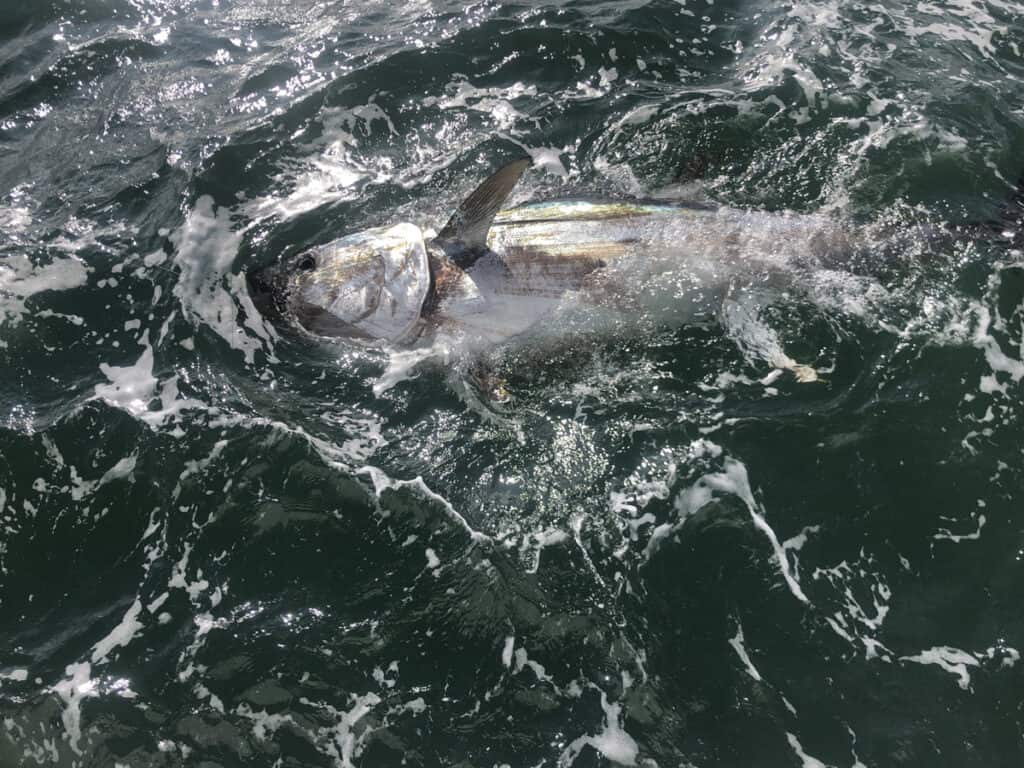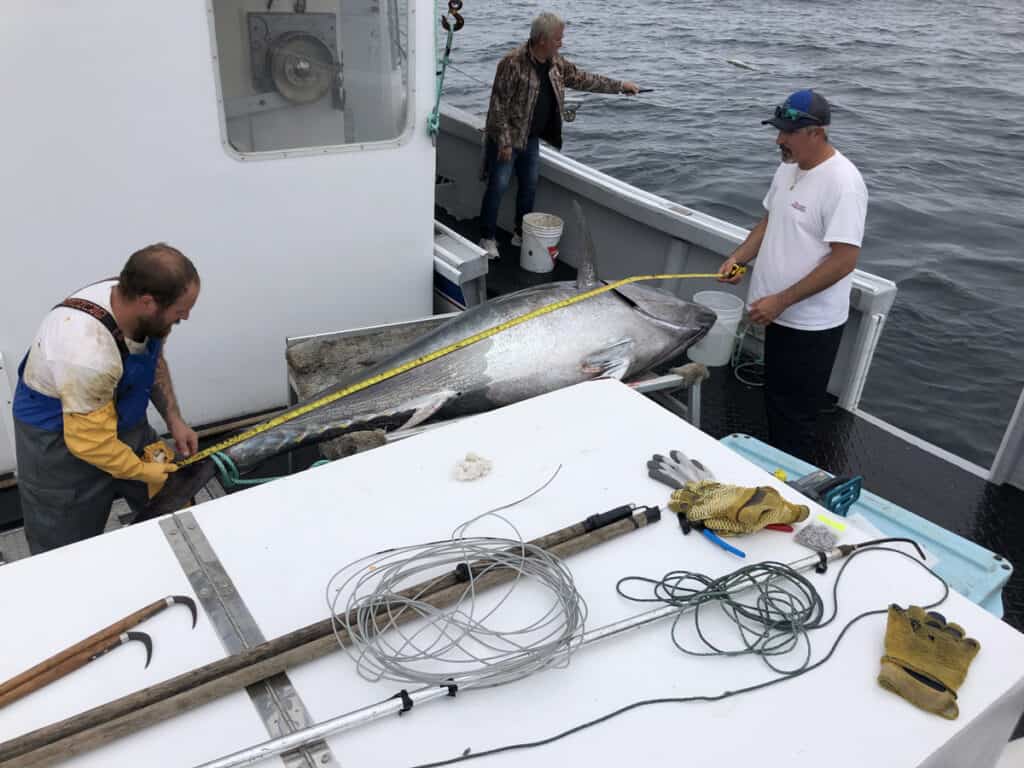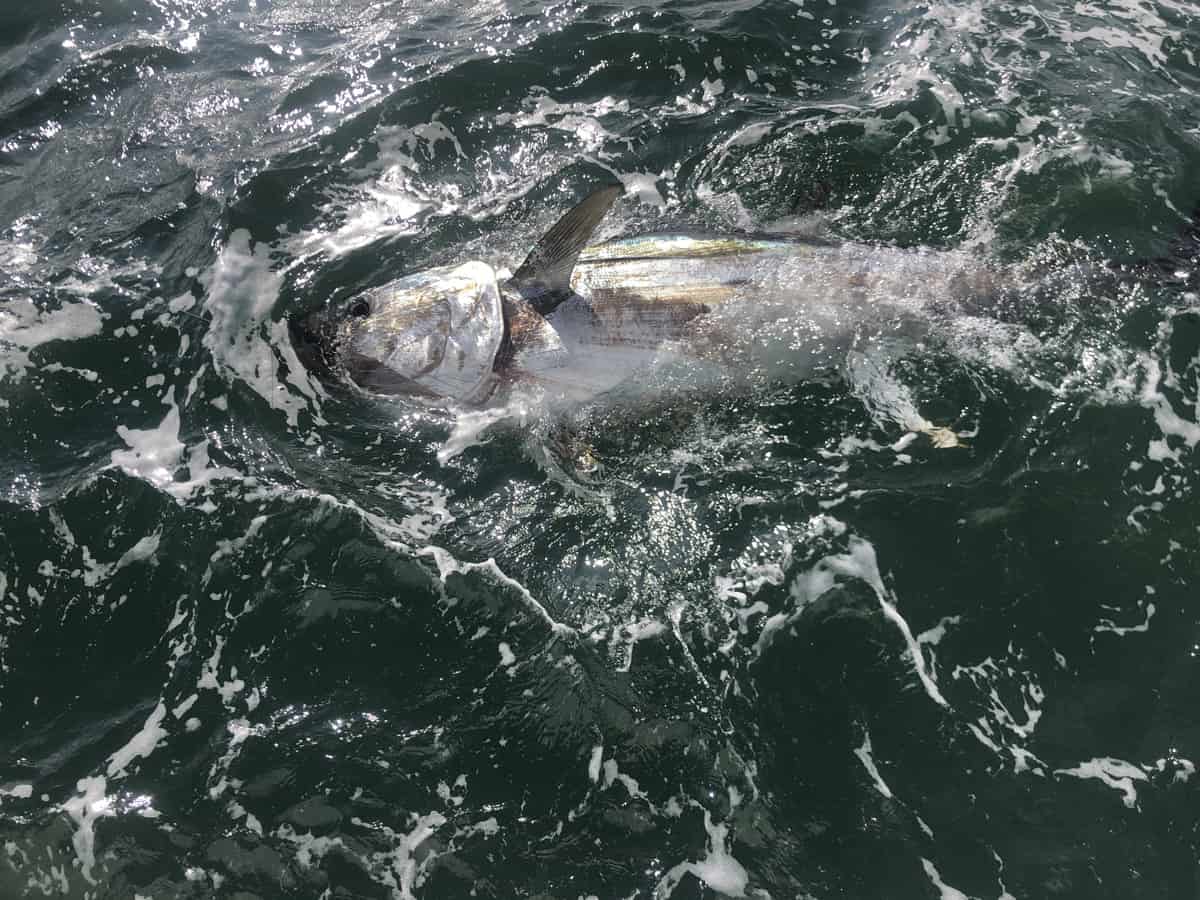by Karen Pinchin
Two hours after untying from downtown Halifax’s dark harbour, the Pelagic Predator—a white, 15-metre fishing vessel captained by 38-year-old Camille Jacquard—rumbled atop a patch of Atlantic Ocean called the Darby Bank. On this bright fall day in 2020, the rising sun sparkled on a horizon of steel-blue waves. Steering the newly built vessel with easy confidence, Jacquard wore his usual necklace: a gold charm of a leaping tuna.
With three children to support and bills to pay, Jacquard fishes for a living year-round, including for lobster and swordfish; sales of bluefin tuna to well-heeled buyers in Japan comprise only a small slice of what he earns every year. His prowess in finding and catching the huge, deep-diving fish has won him trophies and accolades, but he also loves taking part in the data-gathering that is helping scientists understand and protect Atlantic bluefin populations.

To fill his commercial quota for Atlantic bluefin tuna, Pelagic Predator captain Camille Jacquard uses an electrified harpoon to kill each fish, a technique that can fetch higher prices on the Japanese market 
Fishers Eric Jacquard and Matthew Corporon tend to lines, nestled in holes drilled into a picnic table, aboard the Pelagic Predator
Over the past three decades, ambitious tagging and tracking collaborations between commercial fishermen and research scientists across Canada have transformed the reach and scope of ocean conservation. The work is a delicate dance of trust and money, pride and accountability. And it’s why, instead of catching and killing the first giant tuna they landed that day, Jacquard and his crew instead planned to tag it and set it free.
For generations, Jacquard’s Acadian ancestors watched some of the biggest fish in the world school off Nova Scotia’s jagged coast. Back then, the biggest bluefin in Canadian waters grew to more than two metres long and weighed in at more than 350 kilograms, the weight at which they were dubbed “granders” instead of simply “giants.” In 1979, an angler named Ken Fraser landed a 675-kilo bluefin near Auld’s Cove, Nova Scotia. It was the biggest Atlantic bluefin ever recorded, and likely the last of its size. Throughout the 1970s and 1980s, demand for bluefin flesh for the Japanese sushi market hollowed out the species, earning fishermen and distributors millions of dollars. The boom also sparked a population crisis that led to serious concern in the 1990s and 2000s that bluefin could go extinct within a generation. In 1993, international tuna scientists warned that Atlantic bluefin populations off the United States and Canada had plummeted 90 per cent from 1975 levels.

Part of the challenge with gathering data on bluefin populations, says Acadia University bluefin expert Mike Stokesbury, is that the powerful, warm-blooded fish ranges so widely that it has been hard to gather data on where it travels, spawns, and feeds. Without sufficient data, fisheries managers and governments have long struggled to calculate appropriate limits to how many bluefin, and at what sizes and in which seasons, can be sustainably pulled from the ocean. Which is why, he says, tagging collaborations with fishermen like Jacquard have proved vital.
“In 1995, no one would ever have thought you could catch a fish off Cape Breton and then you could catch a fish off Ireland and they might be from the same stock,” says Stokesbury, who helped co-found the Halifax-based group Ocean Tracking Network. That group compiles and stores much of the world’s fish tracking data for hundreds of species and has deployed more than 2,000 tracking receivers across five oceans alongside seven continents.
Fish tagging is a simple process of marking a fish and then waiting for it to be caught again, a technique first formally practised in the mid-1800s by wealthy Scottish landlords curious about the provenance of salmon in their rivers. In the mid-1950s, a wartime naval architect-turned-biologist named Frank Mather III pioneered the first research project to track Atlantic bluefin. While troubleshooting his equipment alongside fishermen who fished for a living, Mather invented the first plastic dart strong and sturdy enough to lodge firmly in the body of a fast-swimming tuna.
More recently, advances in tagging technology include acoustic tags that ping off underwater receivers and can last for up to seven years, pop-off satellite tags that gather data and then eject toward the ocean’s surface to dump data toward satellites, and tiny tracking chips as small and thin as fingernails powered by tiny batteries initially developed for cell phones. These devices have revolutionized our understanding of a wide range of species, from the Sargasso Sea-spawning American eel to the highly migratory bluefin.
In the mid-2010s, back when Stokesbury first started tagging tuna alongside renowned researcher Barbara Block and her Tag A Giant program out of Cape Breton’s Port Hood, many fishermen deeply distrusted their group and their methods. “A rumour when I first started was that we were putting tags on them so they would swim to the States and show the US fishermen where the fish were,” he says.
It took weeks, sometimes years, for them to convince the members of the Port Hood community that their main objective was simply to understand more about tuna and its life cycle, not to interfere with livelihoods. “The valuable part of bluefin tagging, in my mind, is just to tease out the mixing rates and stock structure so that we’re able to properly quantify what fish are being taken out,” says Stokesbury.
In 2002, Camille’s father, Eric Jacquard, the then-president of the Southwest Nova Tuna Association, met an ambitious Massachusetts-based bluefin researcher named Molly Lutcavage. The pair hit it off and started working together to tag tuna every fall with the scientist’s Gloucester-based Large Pelagics Research Program team. Even when Lutcavage wasn’t on board, Eric and Camille often inserted old-fashioned streamer tags (sometimes also called spaghetti tags) into fish that were caught but weren’t the right size or quality. More data, they figured, was better than no data.
Back on that fall 2020 day, as they headed to the Darby Bank—where they knew the bluefin would pursue huge herring schools—Jacquard’s crew rigged up ropes to the Predator’s white, hinged, tuna-fighting chair. Camille only had three commercial tags left that season, so he was feeling the pressure to select the highest-quality round, fat fish to land and sell that day.
Within minutes of dropping the first baited lines into the water, one of the boat’s long rods sprang with a violent hit. The reel’s drag screamed as a bluefin pulled coloured line off its huge spindle. Eventually the fish slowed, and the angler-in-training slowly started to retake lost ground. “Every inch counts,” said Eric, nodding his head. Watching the inexperienced angler lurch and puff, he quickly intervened. There’s a trick to the fighting chair, he advised: pull backwards, then tip its hinge quickly forward while reeling spurts of line back onto the reel.
For nearly an hour, the fish remained invisible, running deep in the ocean, gradually conceding line until it breached the surface with a violent, silvery flick of its tail. In the meantime, the boat’s radar filled with more tuna. We were in the thick of them. From one brief glimpse, Eric estimated the fish on the boat’s line likely weighed 270 kilograms. As the angler drew the fish closer and it thrashed its enormous tail, Jacquard’s first mate, Matthew Corporon, extended a metal gaff and line running out from the side of the boat. They wanted to hook into its mouth and hold it still.
“We aim for 100 per cent survival on tagging,” Camille said, as Corporon jabbed a long stick—preloaded with an identifying tag attached to a plastic anchor—into the tuna’s back. The plastic piece lodged firmly, near its dorsal fin, as the proud angler and his buddies snapped photos over the side of the boat, straining to get both man and giant creature in the frame.
For hours, the group caught, tagged, and set tuna free, until Jacquard decided it was time to harvest the final three fish to fill his commercial quota. For that, he used an electrified harpoon to shock and kill bluefin drawn by chumming, the dropping of dead fish parts, off the side of the Predator’s hull. The technique, his Japanese buyers had once informed him, means higher-quality flesh and a better price on the docks.

Camille and Eric Jacquard tagging a bluefin tuna off Port Hood, Nova Scotia—the fish is on deck to get measured, tagged, and then returned to the water. 
Charter clients get a taste of bluefin tuna sashimi as Eric Jacquard slices up a cut from the head as a mid-day snack
“The community of fishers who catch big fish is a vibrant one,” Fisheries and Oceans Canada (DFO) biologist Dheeraj Busawon says, although, like Stokesbury, he also encountered an initial reluctance by commercial fishers to participate in DFO’s sampling programs. They started with two participants in 2010; they’re now up to 15 fishers in a good year. “The whole goal is to better manage the resource, [and] the better your data inputs, the better your models,” he says. Instead of being afraid of the data, he has increasingly noticed that fishers, like the Jacquards, regard having more collective knowledge as a blessing, not a curse, as scientists like himself and Stokesbury—and bluefin as a species—increasingly benefit from fishers’ hard-won generational knowledge and expertise.
Halfway through Jacquard’s last bluefin-fishing day in 2020, they picked up additional herring bait from a boat floating nearby. They released the bait together and a rush of bluefin followed eagerly, some jumping clear out of the water in magnificent arcs before landing with huge splashes. “Does this fish look endangered to you?” Eric Jacquard shouted at me, flashing a huge, confident smile. At that moment, all I could do was smile back, and hope that one day, the data might prove him right.
